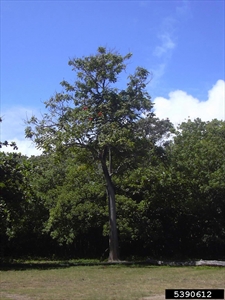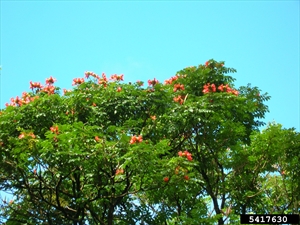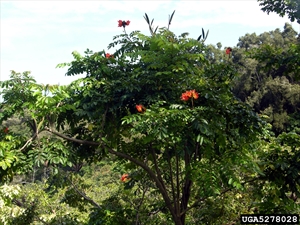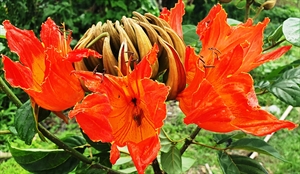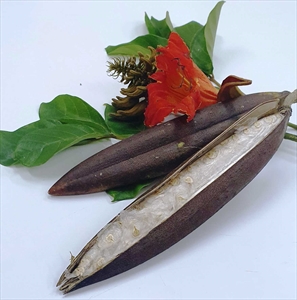- Worldwide distribution. In Australia and many Pacific island countries.
- An invasive tree especially in high rainfall disturbed areas along roads, waterways, and at forest margins where it competes with native vegetation. It also competes with crop production. Alternative view is that it revegetates disturbed areas, providing habitat for native birds and animals.
- Grows up to 35 m with spreading crown, slightly buttressed trunk, compound leaves with 11-15 leaflets, each up to 15 cm long, in opposite pairs. Flowers in large dense clusters at tips of branches, individually enclosed in boat-shaped, leaf-like structures (sepals). Petals reddish-orange, fused together, somewhat tulip-like. Seedpods flattened, brown, erect, releasing up to 500 light, winged seeds.
- Spread: masses of wind-dispersed seed and by suckering.
- Biosecurity: regulate entry of trees and their distribution locally.
- Natural enemies: non-specific caterpillars, and the fungus Ceratocystis are reported.
- Cultural control: pull or dig out seedlings, but only when young, otherwise suckers grow from the roots.
- Chemical control: in Australia: triclopyr + picloram; triclopyr + picloram + aminopyralid; glyphosate (and Fiji).
Pacific Pests, Pathogens and Weeds - Online edition
Pacific Pests, Pathogens, Weeds & Pesticides
African tulip tree (436)
African tulip tree. It is also known as fireball, or flame of the forest.
Spathodea campanulata. It is a member of the Bignoniaceae.
AUTHORS Grahame Jackson & Aradhana Deesh
1Information from Warea Orapa (2017) Impact and management of invasive alien plants in Pacific island communities. In: Ellison CA, et al. (eds) Invasive Alien Plants. CAB International. (https://www.cabi.org/ISC/FullTextPDF/2017/20173322107.pdf); and African tulip tree Spathodea companulata. Brisbane City Council weed identification tool. (https://weeds.brisbane.qld.gov.au/weeds/african-tulip-tree); and Weeds of Australia, Biosecurity Queensland Edition. Queensland Government. (https://keyserver.lucidcentral.org/weeds/data/media/Html/spathodea_campanulata.htm); and from Spathodea campanulata (African tulip tree) (2019). CABI Invasive Species Compendium. (https://www.cabi.org/isc/datasheet/51139). Photos 1,3&5 Forest and Kim Starr, Starr Environmental, Bugwood.org. Photo 4 Joy Viola, Northeastern University, Bugwood.org. Photo 6 Tony Pernas, USDI National Park Service, Bugwood.org.
Produced with support from the Australian Centre for International Agricultural Research under project HORT/2016/185: Responding to emerging pest and disease threats to horticulture in the Pacific islands, implemented by the University of Queensland and the Secretariat of the Pacific Community.


